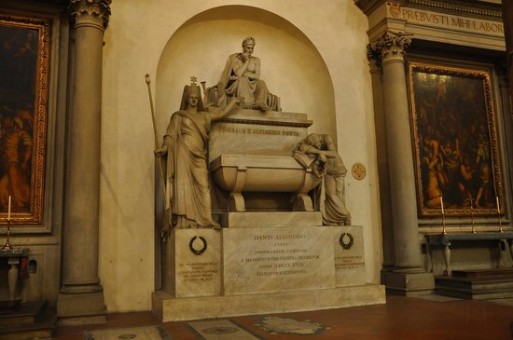The Basilica di Santa Croce (Basilica of the Holy Cross), also known as the Temple of the Italian Glories, is the principal Franciscan church in Florence, Italy and the largest Franciscan church in the world. Construction of the church began in 1294, and in 1863, a 19th century, neo-gothic, polychrome marble facade was added to the exterior of the building. The result is a stunning piece of architecture that boasts 16 chapels, a magnificent Renaissance-style cloister designed by Brunelleschi, and frescoes by Giotto and Gaddi, among other artistic treasures. The basilica is also a mausoleum housing the tombs of some of Italy’s most gloried historical figures.
The Basilica di Santa Croce is the burial place of Michelangelo, Galileo, Machiavelli, Foscolo, Gentile and Rossini. Galileo, who in 1633 was convicted of heresy by the Roman Inquisition, was not allowed a Christian burial until 1737, 95 years after his death. Niccolo Matas (the Jewish architect who designed the church’s 19th-century marble facade) had wanted to be buried, with his peers, within the walls of the church, but because he was Jewish, he is was instead buried beneath the porch. On the steps of the basilica is a monument to Florence-born Dante Alighieri, author of the Divine Comedy (widely considered a master work of world literature). Although Dante’s final resting place is in Ravenna, not Florence, a beautiful cenotaph built between 1819 and 1830 by neoclassical sculptor Stefano Ricci commemorates this most important Florentine. Engraved on the marble of the cenotaph, which features allegorical sculptures representing Italy and Poetry mourning the loss of consummate poet, is the script, “Onorate L’Altissimo Poeta,” which means, “Honor the Poet of the Highest Regard.”

 The Tombs of the Basilica di Santa Croce
The Tombs of the Basilica di Santa Croce




 Recovering Cremation Remains After the Los Angeles Fires
Recovering Cremation Remains After the Los Angeles Fires
 “As Tears Go By” by Marianne Faithfull
“As Tears Go By” by Marianne Faithfull
 “The Sea” by John Banville
“The Sea” by John Banville














